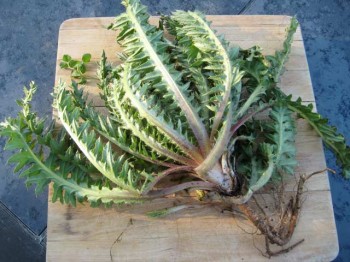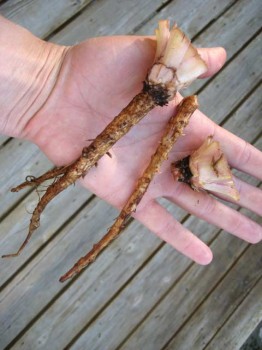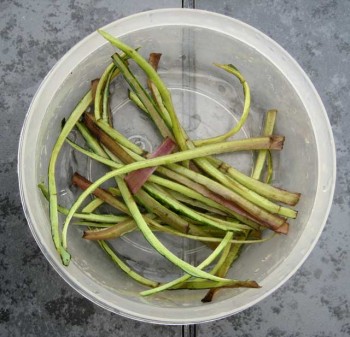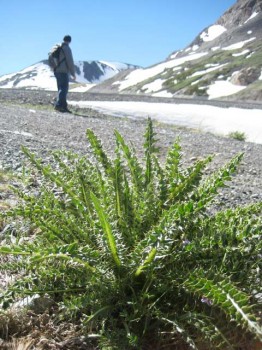
Don’t get too excited. There isn’t a “wild artichoke” that I know of per se. But there is a pretty good substitute for it, if you don’t mind the risk of getting prickled and are willing to put in a bit of work to get at it.
Weed Demolition Discovery
A week and a half ago Gregg and I were offered the opportunity to clear our beloved weeds from a very productive bed that his parents, who co-own the house, decided to cover with weed barrier fabric and mulch so they could have “at least one thing that’s perfect,” in the back yard, as Nancy explained it to me.
Ensuing depression aside, I headed out there at 5:30 am on the appointed weed destruction day and dug three non-stalk-producing thistle rosettes, taproots and all. I’d been meaning to try thistle roots, though after a few failed experiences both with thistle leaf midribs and taproots (in both cases I’d harvested them at the wrong time of year and from plants that were far too mature), they’d landed themselves near the end of my list.
In this case, however, the baby thistles were going to die anyway, so I dug them up and shoved them in the refrigerator, where I proceeded to ignore them for several days with the exception of the occasional prickly mishap from reaching into the veggie drawer too hastily.

Crowning Achievement
Thistle leaf midribs and young stalks are edible if you cut away the spines. They are celery-like, but fibrous in my few experiences eating them raw, so I have generally ended up chewing the midribs for the juices and then spitting the fibers out.
When I finally got around to eating the thistles I dug from the back yard, I cleaned, peeled and boiled the taproots. They came out okay but nothing to write home about. Of course, it might be a little late in the season for roots, anyway, as they are supposedly better in early spring or late fall when the majority of the plant’s energy is within them and not dedicated to producing leaves or flowers.
On the other hand, the “crown”—that part of the plant where the leaves attach to the taproot—was amazing! I had separated the roots already, so I was left with the whole thistle full of leaves, and to get what I’m calling the crown I made my second cut a little bit up the leaf stalks themselves, before the start of the spines, getting the youngest part of the leaves. The biggest crown was about 1 x 1.5 inches and the smallest was significantly smaller. I boiled the crowns along with the roots and when I cut into the biggest one it had a soft center.
“It tastes just like an artichoke!” Gregg exclaimed upon tasting it. Could it be?

We liked the thistle crowns so much that instead of discarding the remainder of the prickly leaves as I had planned due to lack of excitement over pricker removal, in the end I painstakingly sliced the leaves and attached spines off maybe 30 of the bigger leaves and boiled those midribs as well. They tasted like artichokes too!
That night I left the dishes on the counter, including the cooking pot, and the next morning the cooking water had turned a deep black. Gregg was a bit frightened by it, but not I, for in all my days living in Los AngelesI ate a lot of globe artichokes—and they, too, turn cooking water black.
Thistles and Artichokes are Related
A quick jaunt to Wikipedia revealed the relationship: “The globe artichoke (Cynara cardunculus var. scolymus) is a perennial thistle of the Cynara genus originating in Southern Europe around the Mediterranean.” Okay, so not the same genus (I think I may be eating Cirsiums, though for a more in-depth treatment of thistle genera please see my entry Thistle Snack Sticks, and for an even more in-depth treatment see Thayer’s Forager’s Harvest, 2006). Not the same genus—but they are both thistles of the family Asteraceae.
As I hopped around the kitchen, squealing about the discovery, Gregg asked this: “Even if artichokes are related to thistles—it can’t be the same thing to eat the heart of an immature artichoke flower as it is to eat the crown of a thistle, can it?” Great question, Gregg!
No, even though the thistle crown tasted very much like globe artichokes to us, to make a better comparison between the two plants we’d need to eat the immature heart of a thistle flower. Thayer explains, “it is possible (although not necessarily pleasant) to peel the bristly bracts from the outside of a thistle flower bud (well before flowering time) and expose a tiny, tender, delicious, artichoke-like heart,” before stating that the small size of the thistle heart makes it hardly worth the effort.
We discovered that the crowns, on the other hand, are not so difficult to harvest. Granted, you stand a chance of killing the plant to get at the crown—but killing thistles is often the goal, isn’t it? If you dig one up, though, I do think it’s a good idea to eat as much of the plant as you can. If you’re going this route, then, definitely eat the roots and the midribs while you’re at it because they’re worth it, providing you’ve selected a worthwhile specimen—which brings me to our second, less successful attempt.

Attempt #2: Not So Successful
Regarding hooker’s thistle (C. hookerianum), Kershaw et. al. (1998) state that “the roots of the young (1st-year, non-flowering) plants were sometimes eaten raw. …The Flathead tribe enjoyed them so much that they imposed a taboo to prevent people from picking too many.”
We enjoyed the thistle parts so much I decided to make them again for Jim and Nancy. I dug up a few rosettes—though I admit at least one looked older, the leaves more upright and developed perhaps, and I might have even seen the dead flower stalk of the previous year’s plant, indicating that it is not a first year rosette as Kershaw et. al. say the Flathead tribe ate.
Those later-than-first-year rosettes had tougher leaf midribs and smaller “hearts” so they were much less palatable than my first batch. After 20 minutes of boiling I still found myself chewing on the midribs and then spitting out the fibers. I did have a few young-ish thistles in the bunch I collected this last time—and while lacking much of a heart, the midribs were fine; in fact, the spineless part of the leaf midribs were much longer and I chopped those where the spines started, not wanting to bother de-spining the young leaves higher up.
Still, I believe now that if I want that “wild artichoke” experience from a thistle, the ones to aim for are the new 1st-year rosettes, low to the ground but wide and full. This should yield a bigger heart and less fibrous midribs.
Since then I’ve searched for the “perfect” thistle rosettes of my mind’s eye, but alas, I fear the “heart” of thistle crown season may have passed already—and I say this at 11,000 feet, where the growing season is later—so I may just have to wait until next year to test the hypothesis further. If something changes, of course, I’ll let you know in 1,250 words or less.

[…] adventures in wild thistle eating! […]